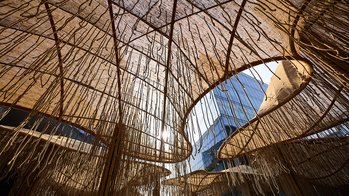
In an attempt to highlight the UAE’s rich natural environment at the ongoing Dubai Design Week, US studio OBMI has created an installation that awakens new possibilities in the urban landscape. Named Once Upon a Forest, the installation has been designed and created by OBMI for the eighth edition of Dubai Design Week with the theme Design with Impact which aims to question how sustainably designers can create designs. Here is a detailed report on SURFACES REPORTER (SR).

OBMI’s Once Upon a Forest installation commemorates the environment of the seven emirates by supporting the preservation of mangroves for a better sustainable future.
Seen on the coastlines of the UAE, the mangrove forests are the most valued natural resource of the region. OBMI’s Once Upon a Forest installation, which has been showcased at the central location of Dubai Design Week, commemorates the environment of the seven emirates by supporting the preservation of mangroves for a better sustainable future.

The maze-like arrangement of the installation is handcrafted in 2,700m of bamboo, 350sqm of jute rope and 30km of jute mesh.
The Once Upon a Forest installation features a gentle slope in organic curves and lines that highlight the region’s mangrove forests that are closely associated with the United Arab Emirates. The installation encapsulates the beauty of the realistic environment of the mangroves. The installation complements the contemporary design event through its fluidity in close association with the diverse landscape of the UAE.

The installation encapsulates the beauty of the realistic environment of the mangroves.
The floating canopies continue to play the light and shadow game throughout the day, thereby creating an intimate and serene ambiance. Mimicking nature, the installation offers a dreamlike experience that creates a place of refuge and also educates visitors about the possibilities of resilient mangroves. The maze-like arrangement of the installation is handcrafted in 2,700m of bamboo, 350sqm of jute rope and 30km of jute mesh. All the natural materials have been sourced from the Middle East and North African (MENA) region.

The Once Upon a Forest installation features a gentle slope in organic curves and lines that highlight the region’s mangrove forests.
Within the installation, an integrated audio-visual experience plays information about the mangrove forests. Post the event, Once Upon a Forest will be repurposed for various other events to celebrate Dubai’s natural landscape.
Photographs: Sebastian Bottcher; Courtesy: OBM